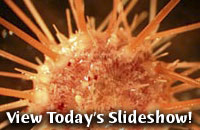|
|
TODAY'S WEATHER
“Rabbit. Rabbit” Shortly before midnight, Dana Yoerger filled his tall plastic mug with ice water and said, “I’m going to watch the hot water show.” It was playing in a lab one deck below where Bob Collier, John Lupton, and Eric Olson were guiding the CTD near the seafloor. They watched their monitoring screens throughout the night for any signs of warm water temperatures—and active hydrothermal venting. It was a long movie, and the ending was disappointing–no signs of venting. Overnight, the CTD searched two areas on either end of a segment of the axial high, covering a total of 10 km. Yesterday, Alvin had covered another 1km section in between, finding mussels, but only dead ones. Today, Alvin set out to fill in a gap that had not yet been searched. But with no signs of venting on either end, the scientists weren’t optimistic. Before going to bed, the scientists mentioned that today was the first day of the month. According to an old custom, you will have luck if your first waking words on the first day of the month are “Rabbit. Rabbit.” Our two Co-Chief Scientists, Steve Hammond and Tim Shank, share a room onboard. Steve awakened first this morning. “I saw Tim stirring in his bunk and I said, ‘Rabbit, Rabbit,’ and I walked over to him, and he said, ‘Rabbit. Rabbit.’ ” It couldn’t hurt. We had already searched 11 km of this area in three different places . There were no signs of heat, and the only “life” we found was dead. As Tim walked on deck to climb into Alvin, Eric Olson, an all-night CTDer, gave him a good-natured send-off: “Find something, Tim. I’m tired of CTDing.” Shortly after noon, Tim reported in from the seafloor, about 1,660m (5478 feet) below Atlantis: “We’re sitting upon a very large field of clams and mussels—live clams and mussels. They’re in all the cracks and crevices of the pillow lava. We’re all smiles down here.” Up there, on Atlantis, we were, too. Dan Fornari shook his head. “It really is like finding a needle in a haystack,” he said. “This spot appears no different on our maps than the three other spots we looked at yesterday and last night.” The newly discovered vent field spans an estimated 60 m by 50 m. It is the first vent field discovered in this part of the Galápagos Rift. It is over 200 miles from the “Rosebud” vent site and the seafloor here is 800 m shallower. The temperature of fluids rising from the cracks in the rocks is 9.5°C (49°F) at the new site. Alvin brought up buckets full of clams and mussels. The clams measured 20 to 23cm (8 to 9 inches) long. The mussels were nearly as big. Dana was waiting on the fantail, as Tim and Rhian Waller, today’s Alvin observers, emerged from the submersible: “We told you,” he said, ‘Don’t come back ‘til you find warm water.’ ” They did. Maybe it was the “Rabbits.”
|
|||||||||||||||||||||||||||||||||||||||||||||||||||||||||||||||||||||||||||||||||||||||||||||||||||||||||||
Mailing List | Feedback | Glossary | For Teachers | About Us | Contact
© 2010 Dive and Discover™. Dive and Discover™ is a registered trademark of
Woods
Hole Oceanographic Institution



